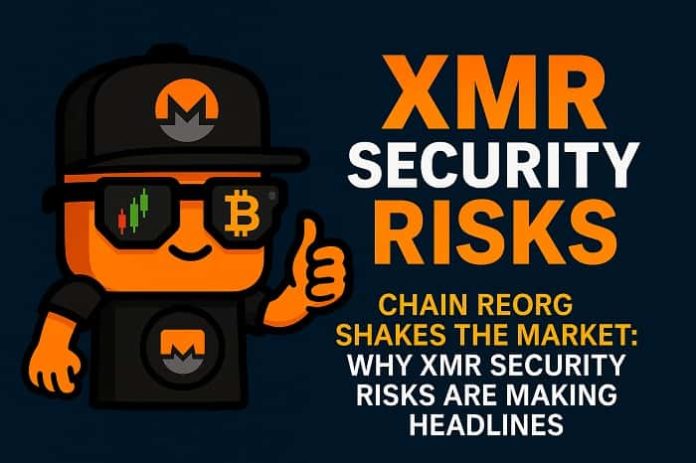
XMR Security Risks Monero, better known by its ticker XMR, has once again captured the attention of the entire crypto industry after undergoing an unexpected 18-block chain reorg. This rare event immediately raised red flags across the market, especially because of the implications it holds for XMR security risks and the potential vulnerabilities it exposes in one of the most privacy-focused cryptocurrencies.
Experts from SlowMist, including the well-known @evilcos, have voiced serious concerns. Their analysis suggests that this chain reorg increases the probability of double-spend attacks, which could undermine confidence in the reliability of Monero’s blockchain. For traders, developers, and investors alike, the question now is whether XMR security risks are becoming a long-term concern or just a short-term glitch.
Currently, many users are being advised to wait for more than 10 block confirmations before considering any Monero transaction safe. This recommendation, though cautious, highlights how the recent event has shaken confidence. When one of the most trusted privacy coins faces such issues, the entire narrative around its XMR security risks shifts dramatically.
Why the 18-Block Chain Reorg Matters for XMR
A chain reorg occurs when blocks already added to a blockchain are replaced by an alternate chain of blocks. For XMR, experiencing an 18-block reorg is not only rare but also deeply troubling. Such events increase uncertainty and make the network temporarily vulnerable. While reorgs can happen naturally in proof-of-work systems, the sheer length of this one means XMR security risks are more tangible than ever. Traders fear potential double-spend attempts where malicious actors could reverse transactions, essentially spending the same XMR twice. This highlights why XMR security risks are not just theoretical but real-world concerns. The fact that SlowMist’s experts are issuing public warnings only underlines the seriousness of the issue.
Double-Spend Risks: How Serious Are They for XMR?
One of the biggest fears with reorgs is the potential for double-spend attacks. In this case, SlowMist warned that the probability is significantly higher now for Monero. Double-spending undermines the integrity of any cryptocurrency, but with XMR security risks, the stakes are even higher because Monero has always branded itself as the gold standard in private and secure transactions. If attackers exploit this vulnerability, it could trigger market-wide panic. Exchanges might pause deposits and withdrawals, traders may exit positions, and the long-term trust in XMR security risks could lead to declining adoption. However, not all is lost. Some experts argue that Monero’s active developer community can and will respond quickly to patch vulnerabilities. But until such fixes are rolled out, the shadow of XMR security risks looms large.
Market Reaction to XMR Security Risks
Following the news of the reorg, Monero’s price showed signs of nervousness, with traders closely watching exchange order books. While XMR didn’t experience an immediate collapse, the underlying sentiment is cautious. Large holders, or “whales,” are reportedly sitting tight, but retail traders have expressed frustration. Social media platforms have been filled with debates about whether XMR security risks could spill over into long-term reputation damage. Still, others believe this is just another stress test that Monero will survive. After all, XMR has faced scrutiny before — from regulators, from exchanges that delisted it, and from critics who claimed its privacy features could never last. Yet the coin persists. Could XMR security risks simply be another hurdle in its long history of resilience?
Why Users Must Wait for More Confirmations
One practical takeaway from this incident is the recommendation for users to wait for more than 10 confirmations. Normally, XMR transactions are considered secure with fewer confirmations, but the reorg changes that. By waiting longer, users can reduce the chance of falling victim to double-spend attacks. While inconvenient, this shows how XMR security risks now require extra caution. It’s a trade-off between speed and security that users must accept — at least until developers address the problem.
Could XMR Security Risks Trigger Wider Concerns in Privacy Coins?
The spotlight on Monero inevitably affects the broader privacy coin ecosystem. Coins like Zcash (ZEC) and Dash may also come under scrutiny, as regulators and traders question whether these networks are any safer. If Monero, with its years of reputation and development, can suffer such issues, what does that say about its peers? This ripple effect could damage the perception of privacy coins overall. Yet, some argue that Monero being battle-tested is actually positive. If XMR security risks can be identified and resolved, it may reinforce Monero’s place as the strongest privacy coin on the market.
The Road Ahead: Can XMR Recover from This?
For Monero, the path forward is clear but challenging. Developers must act swiftly to mitigate vulnerabilities and restore trust. The community, known for being resilient and loyal, will play a huge role in navigating through these stormy waters. The good news? XMR security risks are not insurmountable. Blockchain history shows us that even the strongest coins face setbacks. Bitcoin itself has survived forks, hacks, and endless criticism. Ethereum went through the DAO hack and still thrives. Monero may just be writing its own chapter in that book. Still, investors should proceed with caution. Short-term volatility is expected as news spreads and traders decide whether to stay in or exit positions. Yet for long-term believers, this may be just another reminder of why due diligence and patience are crucial.
Final Thoughts: Why XMR Security Risks Shouldn’t Be Ignored
The recent 18-block chain reorg has placed Monero in an uncomfortable spotlight. While the network has weathered many storms, this incident is a wake-up call that no blockchain is immune from risk. Whether you’re a trader, a holder, or simply an observer, paying attention to XMR security risks is essential. They remind us that decentralization, while powerful, also comes with vulnerabilities. How Monero responds to this challenge will define its future in the eyes of investors and users alike. In the meantime, one thing is clear: XMR security risks are now front and center, and the world is watching closely.
